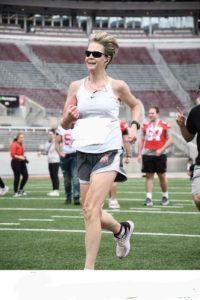Proximal Hamstring Tendinopathy: Michelle’s Success Story
Meet Michelle
Proximal Hamstring Tendinopathy (PHT), also known as High Hamstring Tendinopathy, is a painful condition that can disrupt daily life, particularly when sitting. In this blog post, we’ll explore Michelle’s inspiring journey of overcoming PHT, shedding light on her struggles, misdiagnoses, and ultimate success in managing her condition. If you’re dealing with PHT or similar issues like buttock pain when sitting or pain in the bottom when sitting, Michelle’s story might offer valuable insights and hope.
The Mysterious Onset of Proximal Hamstring Tendinopathy
Michelle’s Proximal Hamstring Tendinopathy journey began in November 2016 during a football game when she suddenly felt pain in her buttocks while sitting on stadium seats. She initially dismissed it, thinking it was unrelated to her active lifestyle. Michelle had been a special education teacher for over 20 years, constantly moving and not sitting much. However, in 2014, she transitioned to a desk job, which marked a significant change in her activity levels.
Despite the pain, Michelle continued running and cycling, completing three half marathons in a year. She even wanted to train for a long bike ride. But by 2017, increased cycling exacerbated the pain, primarily on her left side. This prompted her to explore medical help.
A Long Road to Diagnosis
Michelle’s journey involved consulting numerous doctors. The initial misdiagnosis included piriformis syndrome, but physical therapy didn’t yield significant results. She saw various doctors and received different diagnoses, including ischial bursitis and Tarlov cyst. Each misdiagnosis led to confusion and frustration.
However, Michelle’s determination to find answers led her to explore every possibility. She even considered genetic issues and Tarlov cyst, but these didn’t explain her pain entirely. A pivotal moment came when she stumbled upon a YouTube video by Bob and Brad, discussing high hamstring tendinopathy. A simple self-test of rubbing the affected area without exacerbating the pain led her to suspect this might be her condition.
Michelle eventually saw Dr. Kremchek, who believed it was Proximal Hamstring Tendinopathy. Her diagnosis was a relief, even though the treatment process was challenging. Physical therapy didn’t provide immediate relief, and the slow progress was disheartening. However, she persevered.
A crucial aspect of her recovery was finding the right physical therapist. Dwayne Scotty, who had experienced PHT himself and understood the challenges faced by runners, provided valuable guidance and tailored treatment. Progressively challenging exercises, like elevated bridges, made a significant difference. Michelle was able to resume running and cycling, with her longest run reaching 9-10 miles.
Key Takeaways
Michelle’s Proximal Hamstring Tendinopathy success story offers several valuable takeaways for those dealing with similar issues:
1. Maintain a Symptom Diary
Keeping a journal of daily activities, including exercise, diet, and symptom changes, can help identify triggers and patterns that may contribute to your condition.
2. Individualized Treatment Is Key
What works for one person may not work for another. Seek a physical therapist who understands your condition and is willing to adapt treatment to your specific needs.
3. Stay Persistent and Open-Minded
Don’t be discouraged by misdiagnoses or slow progress. Be willing to explore different options and find the right approach for your recovery.
4. Pay Attention to Your Body
Listen to your body and its responses to exercise and treatment. If something isn’t working, don’t hesitate to change course and try something new.
5. Recovery Can Be a Journey
Recovery from conditions like PHT may take time and patience. Embrace the process, stay consistent, and celebrate the small victories along the way.
Michelle’s story serves as a reminder that with determination and the right support, it’s possible to overcome challenges and regain an active, pain-free lifestyle.
Conclusion:
Michelle’s PHT success story is a testament to the resilience, determination, and the importance of finding the right healthcare professionals when dealing with complex conditions like PHT. If you’re struggling with PHT or similar issues, remember that each journey is unique, and with the right support and persistence, you can overcome the challenges and return to the activities you love.


